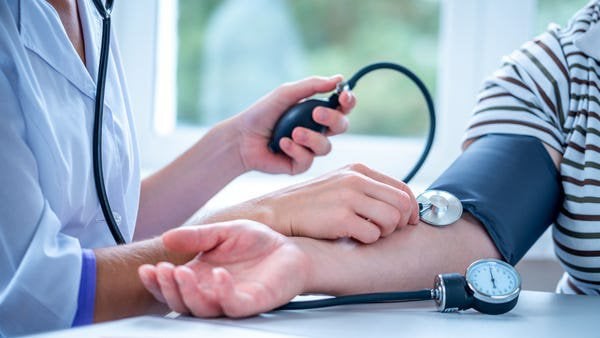High diastolic blood pressure: What you need to know
This is an automatically translated article.
When it comes to hypertension, people are often interested in the concept of blood pressure in general but rarely pay attention to each specific blood pressure index. High diastolic blood pressure can also cause dangerous health complications that people should not be subjective.
1. High diastolic blood pressure
Blood pressure is determined by two numbers, usually written as a ratio. The first number (or top number) is the systolic blood pressure, the second number (or the bottom number) is the diastolic blood pressure. Diastolic pressure is the force exerted by blood on the artery walls during diastole (when the heart muscle is relaxed), this is the lowest blood pressure level in the blood vessels.
There are 3 types of hypertension: systolic hypertension, diastolic hypertension and mixed hypertension. Diastolic hypertension occurs when the bottom number is high, and diastolic hypertension is defined as a diastolic pressure of 90 mmHg or higher. Isolated diastolic hypertension is seen mainly in young adults.
In most people with isolated diastolic hypertension, no specific cause is identified, also known as primary hypertension. In some cases, isolated diastolic hypertension is secondary to another disorder such as thyroid disease, kidney disease, or sleep apnea.
When the diastolic blood pressure is high, the blood vessels will become less elastic, harden and atherosclerotic. Normal diastolic blood pressure usually ranges from 60 to 80 mmHg. If your diastolic blood pressure is 80-89 mmHg, special attention is needed because you already have pre-hypertension. Diastolic pressure usually changes throughout the day. Patients should check their blood pressure several times a day to get an average. Factors that cause fluctuations in diastolic pressure include: nicotine use; stress levels and exercise; posture...
There are 3 types of hypertension: systolic hypertension, diastolic hypertension and mixed hypertension. Diastolic hypertension occurs when the bottom number is high, and diastolic hypertension is defined as a diastolic pressure of 90 mmHg or higher. Isolated diastolic hypertension is seen mainly in young adults.
In most people with isolated diastolic hypertension, no specific cause is identified, also known as primary hypertension. In some cases, isolated diastolic hypertension is secondary to another disorder such as thyroid disease, kidney disease, or sleep apnea.
When the diastolic blood pressure is high, the blood vessels will become less elastic, harden and atherosclerotic. Normal diastolic blood pressure usually ranges from 60 to 80 mmHg. If your diastolic blood pressure is 80-89 mmHg, special attention is needed because you already have pre-hypertension. Diastolic pressure usually changes throughout the day. Patients should check their blood pressure several times a day to get an average. Factors that cause fluctuations in diastolic pressure include: nicotine use; stress levels and exercise; posture...
2. Why is the diastolic blood pressure high?
Causes of high diastolic blood pressure:
Age and sex: The leading risk factor is older age for both men and women, affecting up to 90% of people with hypertension. Men over 45 and women over 55 have a higher risk of developing high blood pressure. However, hypertension is becoming more and more common in adolescents. Men are usually at higher risk than women. Family history: If you have a parent with high blood pressure, you may also have a higher risk of developing it. Obesity: 1/3 of hypertensive patients are overweight. Overweight adults are twice as likely to develop diastolic hypertension as those of normal weight. Children and adolescents who are obese are at increased risk of developing high blood pressure as they grow older. Obstructive Sleep Apnea: This is a condition whereby breathing stops repeatedly during sleep. Most hypertensive patients have sleep apnea.
Age and sex: The leading risk factor is older age for both men and women, affecting up to 90% of people with hypertension. Men over 45 and women over 55 have a higher risk of developing high blood pressure. However, hypertension is becoming more and more common in adolescents. Men are usually at higher risk than women. Family history: If you have a parent with high blood pressure, you may also have a higher risk of developing it. Obesity: 1/3 of hypertensive patients are overweight. Overweight adults are twice as likely to develop diastolic hypertension as those of normal weight. Children and adolescents who are obese are at increased risk of developing high blood pressure as they grow older. Obstructive Sleep Apnea: This is a condition whereby breathing stops repeatedly during sleep. Most hypertensive patients have sleep apnea.

Ngưng thở khi ngủ do tắc nghẽn là một trong những nguyên nhân gây tăng huyết áp tâm trương.
Lifestyle: Smoking, heavy use of alcohol increase the risk of diastolic hypertension. Diets low in potassium and high in salt can increase diastolic blood pressure. A sedentary lifestyle can make you overweight, leading to high blood pressure. Stress, both mental and physical, can temporarily raise blood pressure. Health disorders: Many health conditions are associated with high blood pressure and make it harder to control. Including kidney disease, diabetes and endocrine problems. Medications: Many medications can cause a temporary increase in blood pressure or make the condition worse. Medications include: non-steroidal anti-inflammatory drugs such as: naproxen, aspirin and ibuprofen; intravenous or oral corticosteroids; birth control pill; pain relievers containing pseudoephedrine.
3. Symptoms of high diastolic blood pressure
High blood pressure is known as the "silent killer" because the symptoms of the disease are often silent and difficult to recognize.
Here are some warning signs you have high diastolic blood pressure:
Dizziness Headaches Night sweats Difficulty sleeping Nosebleeds Palpitations Nausea Blurred vision High diastolic blood pressure is different from blood pressure high systolic or both systolic and diastolic blood pressure. It can usually be well controlled with personal and lifestyle changes, although your doctor may also recommend medication.
Here are some warning signs you have high diastolic blood pressure:
Dizziness Headaches Night sweats Difficulty sleeping Nosebleeds Palpitations Nausea Blurred vision High diastolic blood pressure is different from blood pressure high systolic or both systolic and diastolic blood pressure. It can usually be well controlled with personal and lifestyle changes, although your doctor may also recommend medication.
4. Complications of high diastolic blood pressure
Isolated diastolic hypertension by itself increases the likelihood of serious cardiovascular complications. A study published in the Journal of Hypertension noted that adults with isolated diastolic hypertension were twice as likely to have cardiovascular complications, including heart attack and stroke. or or cardiac death compared with adults with normal blood pressure.
5. Prevention of diastolic hypertension

Kiểm tra huyết áp thường xuyên là biện pháp quan trọng nhất để phát hiện sớm bệnh tăng huyết áp tâm trương
Regular blood pressure checks are the most important measure for early detection of diastolic hypertension. Everyone needs to regularly check their blood pressure through periodic health checks or through visits to medical facilities... Personal electronic blood pressure monitors are an effective tool to help people who already have the disease. hypertension and people at risk to regularly check the blood pressure status of themselves and family members. Reasonable diet: Reduce salt intake (less than 5g salt/day); increase the intake of green vegetables and fresh fruits; limit foods high in cholesterol and saturated fatty acids; ensure enough potassium and trace elements. Maintain an ideal weight with a body mass index (BMI) between 18.5 and 22.9; Try to maintain a waist circumference less than 90cm in men and less than 80cm in women. Actively lose weight (if overweight). Limiting alcohol intake; completely stop smoking cigarettes or pipe tobacco. Increase physical activity at an appropriate level: exercise, walk, bike or exercise at a moderate level, regularly about 30-60 minutes a day. Avoid anxiety, nervous tension; attention should be paid to relaxation and reasonable rest; Avoid sudden cold. People with mixed hypertension or isolated diastolic hypertension need to be screened and detected early. In addition to applying the above positive lifestyle changes, patients need to be monitored, long-term disease management and treatment under the guidance of doctors to reduce the risk of complications and to maintain health. Maintain a reasonable blood pressure level.
Blood pressure checkup package at Vinmec International General Hospital helps customers to actively monitor and check blood pressure, at the same time, doctors will rely on examination indicators to make comments on the cause of blood changes. pressure and that will have the potential risk of any disease to take preventive measures.
Blood pressure checkup package at Vinmec International General Hospital helps customers to actively monitor and check blood pressure, at the same time, doctors will rely on examination indicators to make comments on the cause of blood changes. pressure and that will have the potential risk of any disease to take preventive measures.
Please dial HOTLINE for more information or register for an appointment HERE. Download MyVinmec app to make appointments faster and to manage your bookings easily.
This article is written for readers from Sài Gòn, Hà Nội, Hồ Chí Minh, Phú Quốc, Nha Trang, Hạ Long, Hải Phòng, Đà Nẵng.




